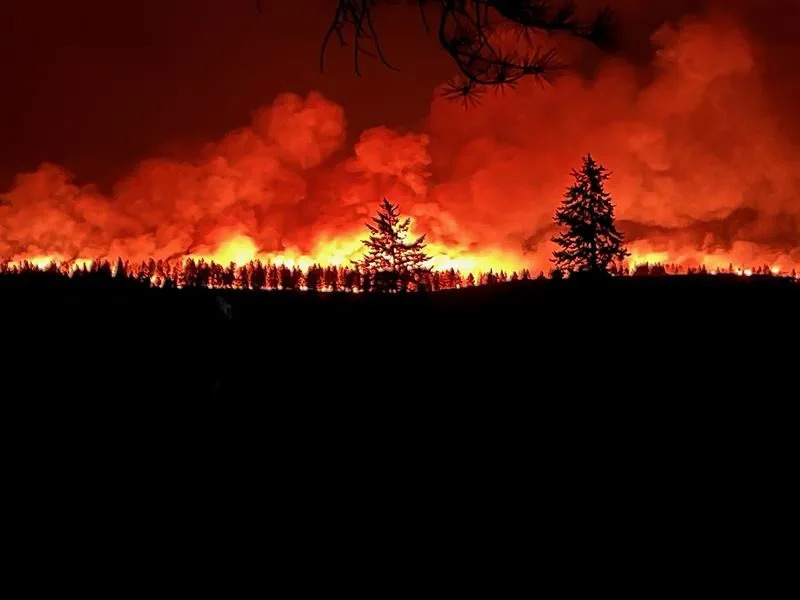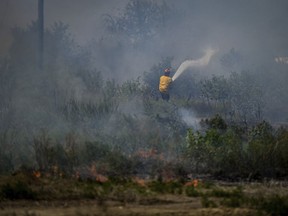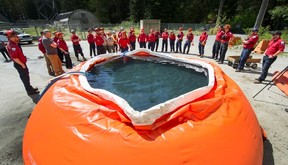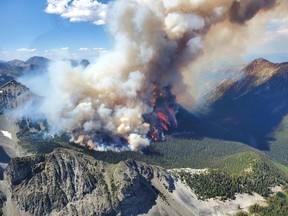The Canadian Press
Fri, July 21, 2023

VICTORIA — The forest and brush around the international airport at Cranbrook, B.C., has been scorched in an all-out effort to protect the vital transportation link from an encroaching wildfire, airport manager Tristen Chernove said Friday.
Wildfire crews were at the Canadian Rockies International Airport in southeastern B.C. overnight Friday monitoring the fires that were purposely lit as a guard from the out-of-control St. Mary's River fire, he said.
Chernove said the controlled burns did their job and are adding to previous wildfire mitigation measures taken by airport officials.
"Last night there were some further ignitions done very close to the airport, which visually can look pretty dramatic, but it was all under control," he said. "The airport itself, while we are in the midst of a lot of smoke, as far as fuel load around us, we are actually quite protected."
He said flights were arriving and departing Friday, but heavy smoke has resulted in some cancellations.
The BC Wildfire Service recommended Thursday that City of Cranbrook properties and leased areas at the airport be placed under an evacuation alert.
The Regional District of East Kootenay followed the wildfire service recommendation late Thursday and issued an evacuation alert for 71 dwellings, including the airport property, because of the 26-square-kilometre fire.
Earlier this week, several homes at the Cranbrook area's Aq'am First Nation were destroyed by the same wildfire.
Chenove said they've been working for the last few years to prepare for just such an event by reducing the fuel load around the airport.
"I would say there's been a lot of proactive measures, including last night, to keep the airport protected from any surprises."
BC Wildfire Service officials have forecast an increase in fires in southern B.C. as cooler temperatures and rain are forecast for the province's north, where some of the largest fires are burning.
But hot, dry weather persists in Cranbrook, Kamloops, the Okanagan, Vancouver Island and B.C. Lower Mainland.
The BC Wildfire Service said Friday that more than 600 lightning strikes were reported in the Kamloops area as a storm swept through.
A new out-of-control wildfire visible from the City of Kamloops was reported about 11 kilometres southwest of the Interior city.
Evacuation alerts for more than 100 properties were issued northeast of Kamloops as crews battled the Lower East Adams Lake fire, said the service.
The service says on its website there are more than 400 active wildfires in the province, with 247 listed as out of control and 23 ranked as fires of note, where they are a threat to safety or are especially visible to the public.
Earlier this week, B.C. reported more than 14,000 square kilometres had been burned so far this season, surpassing the previous record set in 2018.
Federal and provincial government officials have said B.C. and Canada are on the way to the worst fire season in 100 years.
Environment Canada issued heat warnings Friday, saying unseasonably hot weather in B.C.'s Okanagan, Thompson, and Boundary regions will push temperatures into the mid 30s into the weekend.
The agency said daytime temperatures are expected to reach 38 C in the Boundary region, while temperatures in the south and central Okanagan, south and north Thompson, and Fraser Canyon regions will reach up to 36 C.
The latest heat wave broke records in parts of the province, including a 38.2 C temperature in Nelson on Thursday, surpassing the last high from 1938, while records were also set in McKenzie, Nakusp, Richmond and Smithers.
The extended heat wave comes as B.C. expected the arrival of 100 firefighters from Brazil Friday, adding to the province's growing international wildfire force.
Cliff Chapman, BC Wildfire Service spokesman, said about 500 international firefighters are already in the province, boosting the ranks of the more than 2,000 provincial wildfire service personnel on the front lines battling hundreds of blazes.
He said the firefighters from Brazil will join crews from Mexico, the United States and Australia currently in the province.
Bowinn Ma, B.C.'s emergency management and climate readiness minister, recently requested 1,000 international firefighters through the non-profit Canadian Interagency Forest Fire Centre, which co-ordinates national and international fire management.
Chapman said the international firefighters are providing much-needed relief and assistance to crews battling the more than 400 fires currently burning in the province.
This report by The Canadian Press was first published July 21, 2023.
Dirk Meissner, The Canadian Press
Crews from 5 countries step into battle: How firefighters work together on B.C.'s frontlines
Common international approach to wildfires makes it seamless for foreign firefighters to work in B.C.
Author of the article: Glenda Luymes
Published Jul 21, 2023 •
Another 102 Mexican firefighters are expected early next week.

Common international approach to wildfires makes it seamless for foreign firefighters to work in B.C.
Author of the article: Glenda Luymes
Published Jul 21, 2023 •

Wildfires in B.C. have prompted more than 70 evacuation alerts or orders, with many clustered in the province's central Interior. A firefighter directs water on a grass fire on an acreage behind a residential property in Kamloops, B.C., Monday, June 5, 2023.
PHOTO BY DARRYL DYCK /THE ASSOCIATED PRESS
Brazilian firefighters — 103 of them — were expected to arrive in B.C. on Friday, joining 500 others from the U.S., Mexico and Australia, as almost 400 wildfires burned across the province.
In one of B.C.’s worst wildfire seasons on record, the international crews will provide relief and assistance to B.C. firefighters.
But how will they work together?
Provincial fire information officer Mike McCulley said large fires are fought in a similar way worldwide with an organizational structure that allows crews from one country to assist another.
“Wildland firefighting is significantly different than structural firefighting,” he said. Not only are fires bigger and more complex, but they “go on for a long time.”
In addition to the Brazilian ground crews, there are 100 Mexican and 80 American firefighters, including a 40-person parattack crew in B.C. this weekend. There are also 20 American command staff, two American incident management teams of 28 people, two Australian incident management teams of 29 people, and an assortment of engine crews and single-resource specialists, with just under 600 “international resources” scattered across the province.
Brazilian firefighters — 103 of them — were expected to arrive in B.C. on Friday, joining 500 others from the U.S., Mexico and Australia, as almost 400 wildfires burned across the province.
In one of B.C.’s worst wildfire seasons on record, the international crews will provide relief and assistance to B.C. firefighters.
But how will they work together?
Provincial fire information officer Mike McCulley said large fires are fought in a similar way worldwide with an organizational structure that allows crews from one country to assist another.
“Wildland firefighting is significantly different than structural firefighting,” he said. Not only are fires bigger and more complex, but they “go on for a long time.”
In addition to the Brazilian ground crews, there are 100 Mexican and 80 American firefighters, including a 40-person parattack crew in B.C. this weekend. There are also 20 American command staff, two American incident management teams of 28 people, two Australian incident management teams of 29 people, and an assortment of engine crews and single-resource specialists, with just under 600 “international resources” scattered across the province.
Another 102 Mexican firefighters are expected early next week.

A file photo of firefighters training for possible fires at or near Metro Vancouver’s watersheds and regional parks in North Vancouver, B.C. on May 7, 2019.
PHOTO BY ARLEN REDEKOP /PNG
The incident command system provides a standardized approach to the command, control and co-ordination of emergency response, allowing a management team from Australia, for example, to arrive at a B.C. fire and spell off a B.C. team.
“The team is very similar and the transition is very smooth,” said McCulley.
Incident management teams may bring their own supplies, like computers, or B.C. may provide them, depending on where they’re travelling from.
Ground crews will come with their own personal protective equipment, but B.C. will typically provide shovels, pumps and hoses. B.C. has also received firefighting equipment from abroad, such as 10 four-person engine crews from the U.S.
McCulley said when firefighters arrive at YVR, they are typically taken to a briefing facility before being sent to a specific fire centre where they’ll receive more information about the fire, type of work and where they’ll be staying.
After that, they’re put to work and integrated into B.C.’s firefighting apparatus.
McCulley said language barriers are typically not an issue, with many firefighters speaking some English, although the B.C. Wildfire Service provides someone to assist if needed. B.C. also pays the firefighters, with rates agreed upon before they arrive.
The number of international firefighters being used in B.C. is re-evaluated several times a week, he said.
Bowinn Ma, B.C.’s emergency management and climate readiness minister, recently requested 1,000 international firefighters through the non-profit Canadian Interagency Forest Fire Centre, which co-ordinates national and international fire management.

The incident command system provides a standardized approach to the command, control and co-ordination of emergency response, allowing a management team from Australia, for example, to arrive at a B.C. fire and spell off a B.C. team.
“The team is very similar and the transition is very smooth,” said McCulley.
Incident management teams may bring their own supplies, like computers, or B.C. may provide them, depending on where they’re travelling from.
Ground crews will come with their own personal protective equipment, but B.C. will typically provide shovels, pumps and hoses. B.C. has also received firefighting equipment from abroad, such as 10 four-person engine crews from the U.S.
McCulley said when firefighters arrive at YVR, they are typically taken to a briefing facility before being sent to a specific fire centre where they’ll receive more information about the fire, type of work and where they’ll be staying.
After that, they’re put to work and integrated into B.C.’s firefighting apparatus.
McCulley said language barriers are typically not an issue, with many firefighters speaking some English, although the B.C. Wildfire Service provides someone to assist if needed. B.C. also pays the firefighters, with rates agreed upon before they arrive.
The number of international firefighters being used in B.C. is re-evaluated several times a week, he said.
Bowinn Ma, B.C.’s emergency management and climate readiness minister, recently requested 1,000 international firefighters through the non-profit Canadian Interagency Forest Fire Centre, which co-ordinates national and international fire management.

The Texas Creek wildfire south of Lillooet is shown in this handout image provided by the B.C. Wildfire Service. About 150 Canadian soldiers have also been assigned to help firefighters.
PHOTO BY HO /The Canadian Press
Jennifer Kamau, communications manager for the centre, said provinces submit specific requests when they’ve exhausted their own resources. The centre looks across the country, and then to international partners for help.
Canada has agreements with the U.S., Australia, New Zealand, Mexico, South Africa and Costa Rica. This year, with so much fire activity, Canada has had to go “beyond the framework,” with the federal government seeking firefighters from Brazil, France and South Korea, she said.
The agreements go both ways: B.C. firefighters have helped fight fires in Australia in the past.
McCulley said he felt it was particularly important to express the gratitude B.C. fire crews feel toward their “brothers and sisters.”
“It resonates deeply with us,” he said. “We don’t take it lightly.”
The B.C. Wildfire Service website said there are more than 400 active wildfires in the province, with 247 listed as out of control and 23 ranked as fires of note, where they are a threat to safety or especially visible to the public.
Earlier this week, B.C. reported more than 14,000 square kilometres had burned so far this season, surpassing the previous record set in 2018.
Federal and provincial government officials have said B.C. and Canada are on the way to the worst fire season in 100 years.
Jennifer Kamau, communications manager for the centre, said provinces submit specific requests when they’ve exhausted their own resources. The centre looks across the country, and then to international partners for help.
Canada has agreements with the U.S., Australia, New Zealand, Mexico, South Africa and Costa Rica. This year, with so much fire activity, Canada has had to go “beyond the framework,” with the federal government seeking firefighters from Brazil, France and South Korea, she said.
The agreements go both ways: B.C. firefighters have helped fight fires in Australia in the past.
McCulley said he felt it was particularly important to express the gratitude B.C. fire crews feel toward their “brothers and sisters.”
“It resonates deeply with us,” he said. “We don’t take it lightly.”
The B.C. Wildfire Service website said there are more than 400 active wildfires in the province, with 247 listed as out of control and 23 ranked as fires of note, where they are a threat to safety or especially visible to the public.
Earlier this week, B.C. reported more than 14,000 square kilometres had burned so far this season, surpassing the previous record set in 2018.
Federal and provincial government officials have said B.C. and Canada are on the way to the worst fire season in 100 years.
No comments:
Post a Comment